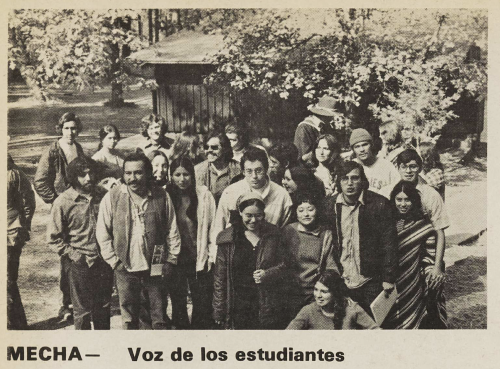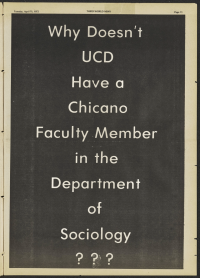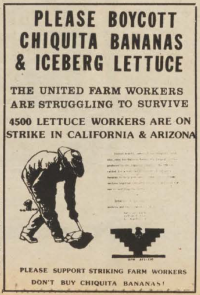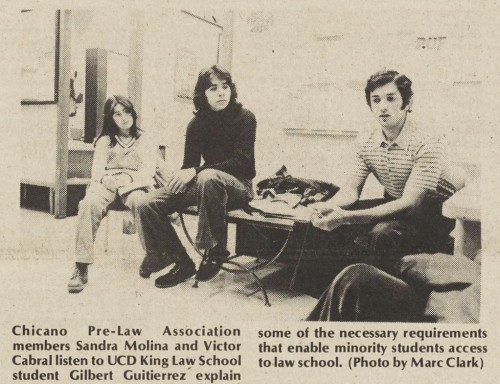Thomas O'Donnell, Ph.D., Principal Analyst, Office of Academic Diversity
twodonnell@ucdavis.edu
Looking back again to that 1968 UMAS Symposium, in addition to drawing attention to the discriminatory education system in California, and the need to establish a “full Chicano studies program,” the participants passed a resolution supporting the creation “of a confederation of Chicano Student organizations.” Within a few years, numerous students heeded that call and formed groups that were political and disciplined-based. In reading through the accounts of these organizations in the 1970s, it is notable that most of them were grassroots, formed and sustained by the students with little or no support by campus administration.
Movimiento Esudantil Chicano de Aztlan

Perhaps the most significant Chicana/o student organization in the early 1970s at UC Davis was Movimiento Esudantil Chicano de Aztlan, or MEChA. The idea for MEChA originated at the conference in Santa Barbara that produced “El Plan,” and the UMAS chapter at UC Davis quickly embraced the concept of creating a broader network of Chicana/o student organizations and became the first to adopt the MEChA moniker. In a profile about the group in 1970, they were described as “the most recent, and perhaps most well organized and responsive of the organizations for the advancement of the Chicano people…The basic purpose of the organization is to get the University to serve the Chicano people as it has served the Anglo population.”[1] In the inaugural issue of the Third World News, MEChA announced its goals, developed during the Santa Barbara conference, which included: “1) acknowledgement as a people, 2) acknowledgement of the vast contributions made by the Chicano to this society, 3) responsiveness on the part of educators who presently are insensitive to the unique educational needs of the Chicano, and 4) the economic improvement of La Raza.”[2]

To accomplish its objectives, MEChA formed a network of committees including Legal Aid, Migratory Education, Boycott, Tutorial, Barrio (community), Chicano Studies, Library, and Public Relations.[3] They sponsored numerous cultural events during the 1970s including festivals (Tardeada), Mexican cultural dances, and performances of folk and revolutionary music. They were closely involved in the development of Chicano Studies at UC Davis in three ways: the recruitment of Chicana/o students (along with any necessary financial aid), establishing Chicana/o-oriented courses, and “perhaps of the largest magnitude,” using the power of the university to improve conditions in “the barrio.”[4] In an article celebrating their tenth anniversary on campus, Victor Perez claimed that among its many achievements, MEChA successfully agitated for multi-ethnic housing, contributed to the hiring of every core Chicano Studies faculty and many staff, including a bilingual counselor with cultural competence.[5]

As with virtually every other Chicana/o student organization, MEChA kept in close contact with, and prioritized the needs of the Chicana/o community, especially with respect to farm workers. They did so by demanding that the university bear some responsibility for the farm workers its mechanization technology displaced and by supporting their organizing efforts through boycotts.[6] In 1972, MEChA “campaigned vigorously” for the defeat of Proposition 22, which would have outlawed union organizing efforts by farm workers.[7]
Chicanos in Health Education

Another example of the characteristic concern for the community by Chicanas/os at UCD is Clinica Tepati. In the fall of 1974, the student organization Chicanos in Health Education (CHE) “began to formulate a bilingual, bicultural clinic to primarily serve the Spanish-speaking community of Sacramento. Clinica Tepati is the culmination of CHE’s efforts.”[8] (The acronym CHE also referenced Che Guevara, a revolutionary leader in Cuba and a physician.)[9] It was the only bilingual clinic in Sacramento and provided “basic health care services including but not limited to health screening, health education, primary health care and patient counseling.” The clinic was staffed by volunteer physicians and more than four dozen students from the medical school.[10] In a statement of their purpose, they noted: “Too often, the educational process becomes an experience which alienates us from our communities by isolating us in universities and hospitals for years at a time. The chance that we will be effective in dealing with Chicano problems diminishes with each day of isolation. By encouraging students to go back to serve their communities, we are making steps to serve present and future needs of our people.”[11]
King Hall Law Student Associations
At the King Hall School of Law, Chicana/o students around 1970 formed the Chicano Law Students Association (CLSA).[12] Through the work of the CLSA, the law school increased its enrollment of Chicano students from 5 in 1970 to 63 four years later. In addition to helping with recruitment, by the mid-1970s, the CLSA also became concerned with retention efforts.[13]

Another law school organization formed by UC Davis undergraduates in 1975 was the Chicano Pre-Law Association. The association’s weekly meetings helped to answer questions for students interested in pursuing law school. Closely aligned with many of the challenges and objectives identified by the Chicana/o Student Movement, they hoped to “identify and interest Chicanos in Law and law related fields,” provide help for “personal and academic problems,” and “supplement Chicano student’s education with community oriented projects.”[14]
In 1981, an umbrella group, La Raza Student Organizations, formed to improve coordination and increase Chicana/o enrollment. The six student organizations included: Chicanos and Latinos Engineering Scientific Society (CALESS), Chicanos in Agricultural Environmental Sciences (CHAES), Chicano Pre-Law Society (CPLA), Chicanos in Health Education (CHE), Movimiento Estudiantil Chicano De Aztalan (MEChA) and Chicano-Mexican & American Service Fraternity (MEX).”[15]
The number of cultural, political, and academic Chicanx/Latinx students organizations in the 1970s and beyond is astounding and requires further documentation. We encourage anyone interested in their particular organization or one that aligns with an area of personal study (for example, engineering, medicine, or law) to review our growing list of suggested topics or propose one that is missing and submit an article.
Read the next article in this series:
Top image: MEChA, voice of the students, Third World News, April 30, 1973.
[1] Anne Nielsen, “Chicanos Organize at Davis,” California Aggie, February 17, 1970. Victor Perez claimed the UCD chapter was “the first campus in the nation to adopt the M.E.Ch.A. name and format.” Third World Forum, May 15, 1979. The format of the MEChA acronym changed several times over the years including MECHA, M.E.C.H.A., and MEChA.
[2] “MECHA-Chicano Unity,” Third World News, October 1, 1970.
[3] “MECHA-Chicano Unity,” Third World News, October 1, 1970.
[4] Robert Aguilar, “What’s Happening in MECHA,” Third World News, May 3, 1971.
[5] Victor Perez, ”M.E.Ch.A. Celebrates Tenth Anniversary,” California Aggie, May 15, 1979.
[6] Anne Nielsen, “Chicanos Organize at Davis,” California Aggie, February 17, 1970.
[7] “This is MECHA,” Third World News, October 31, 1973.
[8] “Tepati Health Clinic - Chicano Success Story,” California Aggie, December 10, 1975.
[9] Francisco Perez, “Chicano Student in Health Education,” Third World Forum, May 15, 1979.
[10] “Tepati Health Clinic - Chicano Success Story,” California Aggie, December 10, 1975.
[11] “Tepati Health Clinic - Chicano Success Story,” California Aggie, December 10, 1975.
[12] An article in the Aggie newspaper from 1969 references the CLSA of UCD holding a rally on the quad: “Chicano Rally Yesterday,” October 30, 1969. An article in the Third World News asserts the “CLSA was “officially formed” in 1970: “Chicano Law Student in Davis; A New Breed of Lawyers,” November 18-25, 1974.
[13] “Chicano Law Student in Davis; A New Breed of Lawyers,” Third World News, November 18-25, 1974. The article cited has a typo that quotes the number of Chicano students as “sixty-thru,” which this author assumes to be sixty-three.
[14] Herb Sala, “Chicanos Organize For Law School Help,” California Aggie, November 20, 1975.
[15] “La Raza Unifies Chicanos,” California Aggie, October 1, 1981.

